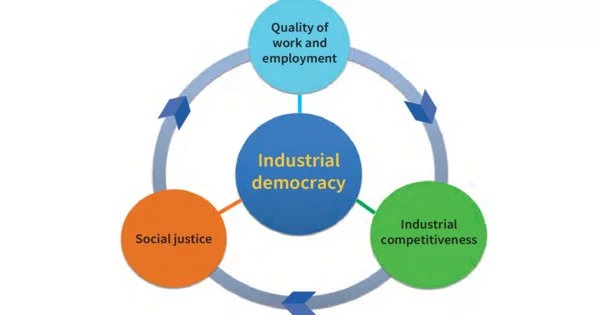Industrial democracy is a workplace arrangement in which employees make decisions and share responsibility and authority. The concept of incorporating democratic principles and practices into the workplace and decision-making processes within an industrial or organizational setting is referred to as industrial democracy. Workers are listened to and participate in decision-making in participatory management organizational designs, but in industrial democracy organizations, they also have the final say (they decide on organizational design and hierarchy). It entails giving workers and employees a say in decisions affecting their working conditions, wages, and overall work environment.
Co-determination is a term commonly used in corporate law, derived from the German word Mitbestimmung. In Germany, companies with more than 2000 employees (or more than 1000 employees in the coal and steel industries) have half of their supervisory boards of directors (which elect management) elected by shareholders and half by workers.
The central idea behind industrial democracy is to shift away from traditional hierarchical structures in which management and owners have sole control over decision-making and instead create a more participatory and inclusive system. It aims to empower workers, improve job satisfaction, and foster a sense of ownership and commitment to the organization by involving them in decision-making.
Although industrial democracy generally refers to the organizational model in which workplaces are run directly by the people who work in them, there are also representative forms of industrial democracy. To facilitate communication between management, unions, and employees, representative industrial democracy includes decision-making structures such as the formation of committees and consultative bodies.
There are several ways in which industrial democracy can be implemented:
- Employee Representation: Establishing mechanisms for employees to elect representatives who can advocate for their interests and participate in decision-making processes. This can take the form of works councils, labor unions, or employee-elected representatives on company boards.
- Co-determination: Granting employees the right to participate in corporate governance by having worker representatives on the company’s board of directors. This approach is more common in certain European countries.
- Profit Sharing: Providing employees with a share of the company’s profits as a form of recognition for their contributions and aligning their interests with those of the organization.
- Participatory Management: Encouraging active employee involvement in decision-making at various levels of the organization, such as through regular meetings, suggestion programs, or quality circles.
- Workplace Democracy: Creating structures for democratic decision-making within the workplace, where employees have a say in matters like work schedules, task allocation, and workplace policies.
Increased employee engagement, improved job satisfaction, better communication between management and workers, and a more harmonious work environment are all advantages of industrial democracy. By incorporating diverse perspectives and expertise from all levels of the organization, it can also lead to more effective decision-making.
However, challenges to implementing industrial democracy include management resistance, concerns about efficiency and productivity, and the need for effective mechanisms to ensure fair representation and prevent conflicts of interest.
Overall, industrial democracy aims to create a more equitable and inclusive workplace by giving employees more say in decisions that affect their working lives, with the ultimate goal of balancing the power dynamics between labor and management.
















